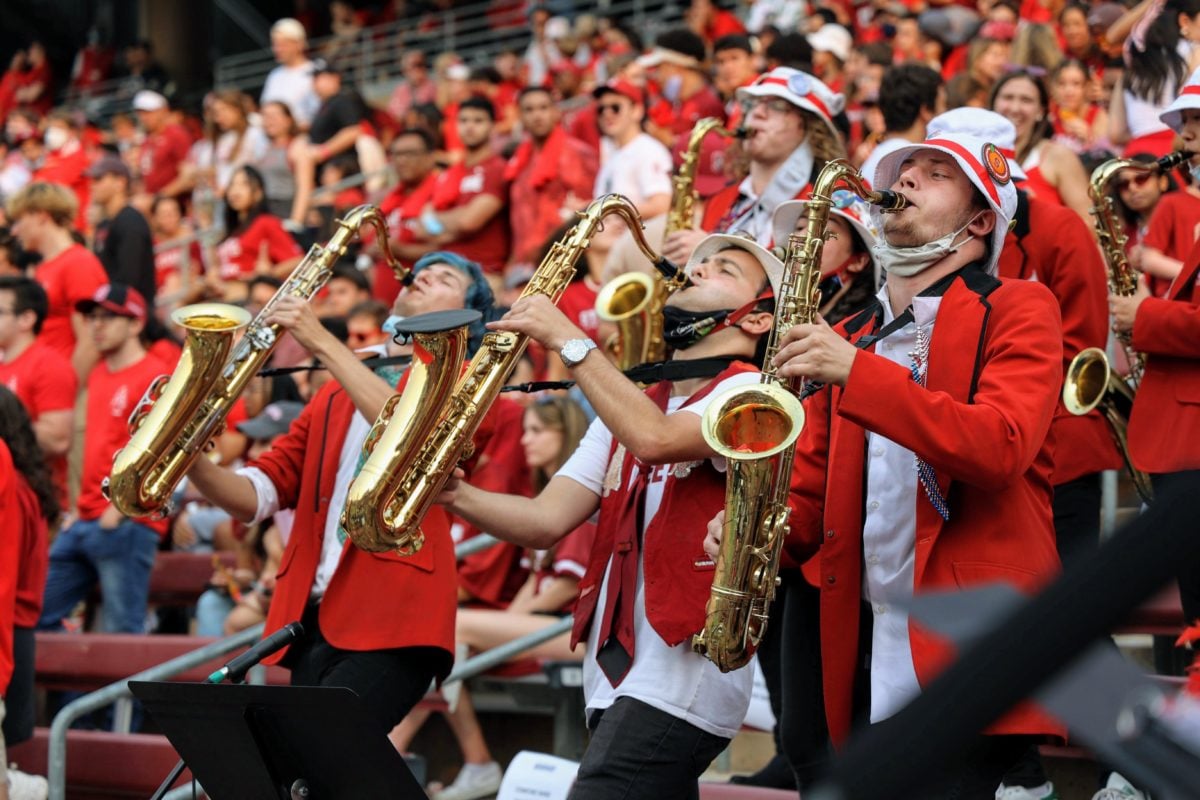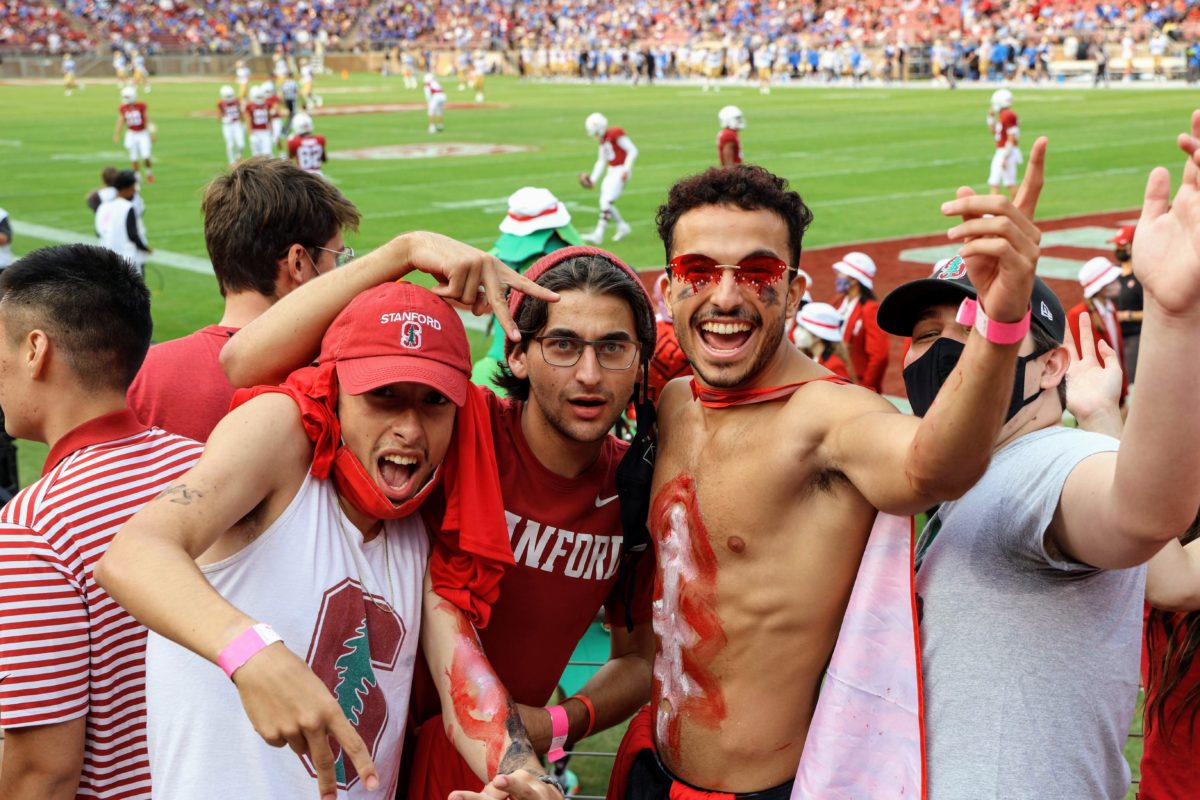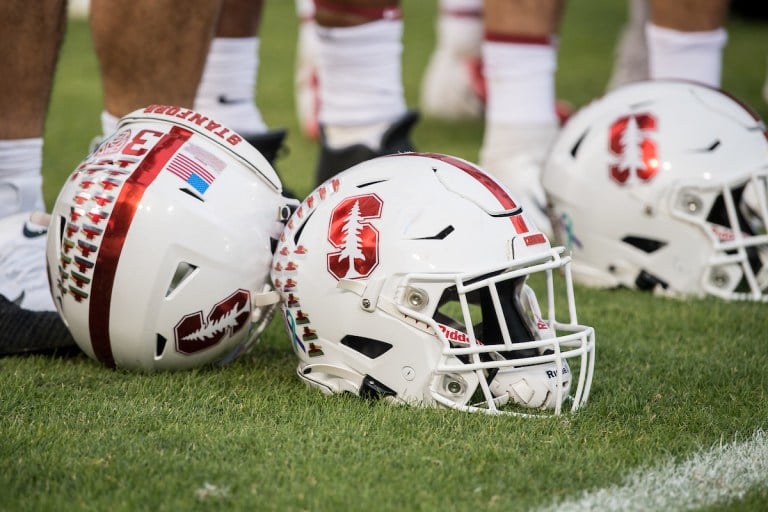The Pac-12 is the Ducks’ to lose. Because of that, No. 3 Oregon’s sights are probably set on opponents more challenging than Stanford. The Ducks (4-0, 1-0 Pac-12) are on a four-game win streak — which includes a statement victory over perennial powerhouse and then No. 3 Ohio State — but the Cardinal (2-2, 1-1 Pac-12) has a history of disrupting. Remember Stanford’s 2018 overtime win?
Can the Cardinal pull off another upset? Jibriel Taha, Daniel Wu and Ells Boone discuss Stanford’s missing players, the pace of scoring and defending the run.
Cybele Zhang [CZ]: As of late, the Cardinal players off the field have been more notable than those on it. Last week, the Stanford running back room was depleted with sophomore Casey Filkins, junior Austin Jones and sophomore EJ Smith all out for undisclosed reasons. Among other players, fifth-year TE/DE Tucker Fisk and sophomore TE Benjamin Yurosek have also missed at least one game. But the trend of missing players doesn’t stop there. Looking back to the last match-up between Oregon and the Cardinal, the main storyline was the absence of three players, including quarterback Davis Mills ‘21, due to a false positive COVID test. How will this weeks’ absences affect Stanford’s prospects? Is an upset still possible with a depleted roster?
Jibriel Taha [JT]: Senior cornerback Ethan Bonner and junior cornerback Zahran Manley are the most important absences for the Cardinal this week, given that the secondary is already depleted due to the long-term absences of junior cornerback Salim Turner-Muhammad and junior safety Jonathan McGill. Despite missing the two juniors; however, the secondary has held up decently thus far, so an upset is definitely still possible with the current active roster. Jones and Filkins are both probable, and they’ll add another dimension to the offense and special teams if they appear on Saturday.
Daniel Wu [DW]: Austin Jones’ availability is make-or-break for this Stanford offense. Jones is the best pass protector in the Cardinal RB room, adds the most in the passing game and allows junior RB Nathaniel Peat to do his best work ripping off big runs as a change-of-pace back. I’m also worried about the absence of starting right guard junior Branson Bragg; Stanford’s offensive line has not played spectacularly of late, and Oregon has a ferocious crew of pass rushers. The Cardinal have pulled off big wins while playing hurt, and the team’s depth is better than it has been in years, so I won’t rule out an upset. But the cards are stacked against the Stanford offense this week.
Ells Boone [EB]: In my opinion, the biggest personnel loss for this week is Branson Bragg, as Daniel noted. Bragg has been the leader and anchor of the offensive line unit so far this season, so his absence will definitely be missed. In his place, junior Jake Hornibrook will slide in at the right guard spot. Hornibrook has started six games so far in his career. As a whole, the offensive line has struggled this year, so it’s never good to lose the main man of the group. Bragg being out definitely hurts the team’s chances (and the run game), but the upset is still possible thanks to sophomore quarterback Tanner McKee and the receiving corps.
CZ: To put it lightly, the Cardinal started slow last weekend versus UCLA. Stanford scored no points in the opening five possessions. How do they right the ship this week? Thus far, the undefeated Ducks, across four games, have only given up 14 total points in the opening quarter. How important is it for the Cardinal to start scoring early?
JT: We know what the Stanford coaching staff wants to do out of the gate: establish the run. They haven’t done that this year, with running backs seemingly running into brick walls the majority of the time they get the ball. If that doesn’t change, the Cardinal will start slowly, and Oregon could take advantage and build an early lead. As we saw last week, this Stanford team has the ability to come back thanks to the play of McKee and the wide receiver corps. But an early deficit is never a good thing, and the slow start cost them the game against UCLA.

DW: The Cardinal team isn’t really built to play from behind. An early score was pivotal to notching the upset against USC, and Shaw seems much more comfortable taking risks as a play-caller when his team is sitting on a lead. It might take a lucky break on one explosive play early in the game, like it did in the Coliseum. But that’s not a tall order — like Jibriel said, Stanford has the talent to score quickly when they need to. Hopefully, McKee’s slow start against UCLA was just from the nerves of a home opener, and hopefully he carries the momentum from his second half performance into the Oregon game. Side note: I’m still waiting for the Cardinal to recreate their vintage performance to upset a ranked Washington team last year, when they scored on their first four drives off nothing but dominant running. When can the Tunnel Workers’ Union step up and take over a game from the get go?
EB: Stanford cannot afford to start from behind come Saturday. In order to have a fighting chance, David Shaw will have to get his offense off to a hot start in what could very well turn out to be a shootout. Even though the team can come from behind, you never want to rely on that, especially against the No. 3 team in the country.
CZ: On the other side of the ball, Oregon scores the majority of its points in the final quarter (13 per game), while the Cardinal are only averaging eight points in that same span. If it’s a close game, how does Stanford ensure it finishes strong, too? (P.S. in that 2018 shocker at Autzen, the Cardinal overcame a 17-point halftime deficit to win in OT, but few current Stanford personnel were even present at that game. Does the Cardinal currently have the weapons and experience to create a similar last-second surge?)
JT: I think so. I was excited to see what McKee could have done to complete the comeback against UCLA had he gotten the ball back — but it was not meant to be, as UCLA staged an almost seven-minute, 75-yard, touchdown drive to seal the game in the fourth quarter, denying the offense that opportunity. Stanford’s wide receiver core has given opposing defenses fits, with junior Elijah Higgins, sophomore John Humphreys and senior Brycen Tremayne using their size to their advantage in the typical Cardinal-wide-receiver way; all are at least 6-foot-3 and over 200 pounds. McKee has been great so far and clearly has good chemistry with the WR core. I wouldn’t be surprised at all if these players stage a comeback at some point this season.
DW: I’m right with Jibriel. The Cardinal passing attack has been irresistible this season and was at its most explosive in crunch time against UCLA. Nothing is off the table if McKee can keep his connection with Higgins, Humphreys and Tremayne going — shout out also to sophomore wide receiver Bryce Farrell, who had a breakout game against the Bruins and gives McKee a speedster to pair with his jump-ball NBA receivers. But the Stanford defense needs to play its part, too. That legendary 2018 comeback was made possible by a timely forced fumble and airtight pass coverage in overtime. Either junior cornerback Kyu Blu Kelly needs to get back to his ballhawking ways or the Cardinal need to rediscover the clutch magic that saw them force two fourth-quarter fumbles last season.
EB: Yes, as Jibriel and Daniel mentioned, Stanford definitely has the weapons to win the game late in the fourth quarter. My only worry though: can the Cardinal defense hold off the Ducks in an end of game scenario? McKee and company have already shown they can make a comeback, but the loss to UCLA happened because the defense could not get a final stop. As long as the passing attack is firing on all cylinders and the defense can just get a stop, Stanford has a chance if it comes down to a close game late in the fourth quarter.

CZ: The Cardinal struggled against UCLA’s run at last week’s home-opener. Now, they face the (arguably more lethal) Ducks, who are averaging 200+ rushing yards per game. What adjustments, if any, should Stanford be making in order to contain RB CJ Verdell (who averages 5.6 yards per carry)?
JT: It’s not just against UCLA they struggled, it’s been all season, giving up 200, 185, 247 and 204 in their four games, respectively. Shaw knows how pressing of an issue this is and on Saturday said. “Bottom line is when you do have guys there, now you’ve got to bring guys down … Like I said early on, if you can run the ball like they were able to and play the game in second and five or less, that’s a tough one.” It seems like it’s much more than a tackling issue, and Shaw and defense coordinator Lance Anderson have to change things up if the Cardinal want a chance to pull off the upset.
DW: Stanford was just plain bullied by UCLA in the trenches last week, and a lack of talent and depth on the defensive line won’t fix itself overnight. There must be some technical things Anderson can tune up this week — it was distressing to see Stanford defenders once again get absolutely flummoxed by zone reads. But to be honest, I think the Cardinal’s most realistic chance on Saturday is to keep pace in a shootout. This Stanford defense can absolutely come up with a game-changing turnover, but they won’t be stonewalling CJ Verdell all game.
EB: I agree with Daniel, I don’t know if the Cardinal really can hold Verdell in check for the entire game. The best defense in this case may just be a great offense, where Tanner McKee leads his unit back to knot the score each possession. Stanford has struggled with the run all season, and, with another dual threat quarterback walking into Stanford Stadium on Saturday in Anthony Brown, it may be a rough afternoon for Cardinal fans.
CZ: Oregon averages 38.8 points per game and, on average, holds its opponents to just 19.5. Score predictions for this weekend?
JT: Stanford 24, Oregon 38 — Stanford hasn’t proven they can stop the run or run the ball themselves, and now they face the No. 3 team in the country. I’m expecting a solid game from McKee, and hey, Oregon has played teams close this year, so maybe this is the time it burns them. But on paper, the clear advantage belongs to the Ducks.
DW: Stanford 42, Oregon 35 (OT) — The last time I picked Stanford in a game I thought the Cardinal had little business winning, it worked out, so here goes. Stanford channels the spirit of their legendary 2012 and 2013 spoiler games and stuns the college football world. If Jones remains out or the offensive line has another off-game, though, take this with a grain of salt.
EB: Stanford 31, Oregon 42 — Oregon’s run proves to be too much for the Stanford defense, and the Cardinal offense cannot quite keep the pace. I think it will be closer than most around the country do, but with Stanford still missing some key guys, this one falls the wrong way for the Cardinal.
